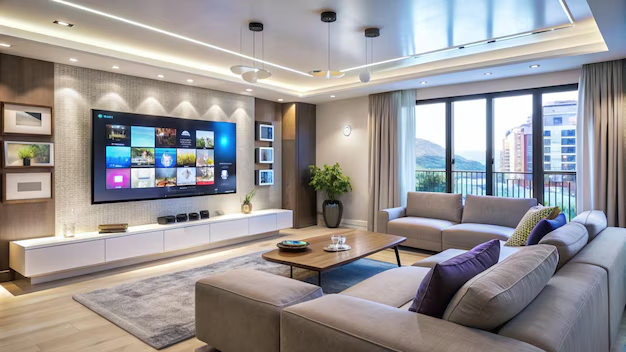A home theater system transforms movie nights, gaming sessions, and binge-watching into unforgettable experiences. But setting one up can feel overwhelming—especially if you’re new to home theater installation. Don’t worry! This step-by-step guide breaks down everything you need to know, from choosing gear to fine-tuning your setup. Whether you’re a DIY enthusiast or prefer professional help, these tips will ensure your home cinema delivers theater-quality sound and visuals.
Why a Home Theater is Worth the Investment
Bringing the Cinema Experience Home
Why drive to a crowded theater when you can enjoy blockbusters in your living room? A well-designed home theater offers crisp visuals, booming surround sound, and comfy seating—all tailored to your preferences. Plus, it adds value to your home and becomes a hub for family gatherings.
Boosting Entertainment Value for Family & Friends
Hosting friends for the big game? A home theater system creates an immersive atmosphere that standard TVs can’t match. With the right setup, you’ll feel every explosion, hear every whisper, and see every detail in stunning clarity
Planning Your Home Theater Setup
Choosing the Right Room for Your Theater
Spare bedrooms, basements, or living rooms work best. Prioritize spaces with:
- Limited windows (to control light).
- Enough wall space for speakers and screens.
- Room for seating (7–12 feet from the screen is ideal).
Room Layout Tips for Optimal Sound and Sight
- Avoid square rooms (they create sound echoes).
- Use dark paint or curtains to reduce glare.
- Place seating centrally for balanced audio.
- Display (TV/projector).
- Speakers and receiver.
- Cables, mounts, and acoustic treatments.
Essential Components of a Home Theater System
Picking the Perfect Display: TV vs. Projector
- TVs (65″–85″): Brighter, easier to set up, ideal for bright rooms.
- Projectors (100″–120″): Better for dark rooms, cinematic feel.
Pro Tip: Pair a 4K projector with a motorized screen for a true theater vibe.
Audio Gear: Speakers, Subwoofers, and Receivers
- AV Receiver: The brain of your system (supports 5.1, 7.1, or Dolby Atmos).
- Speakers: Start with a 5.1 system (left/right fronts, center, rear surrounds, subwoofer).
- Soundbars: Compact alternative for smaller spaces.
Media Players and Streaming Devices
- Blu-ray players, Apple TV, or NVIDIA Shield.
- Ensure devices support 4K HDR and Dolby Vision.
Step-by-Step Home Theater Installation Guide
Wiring and Cable Management Basics
Hiding Wires for a Clean Look
Use wall channels, in-wall conduits, or area rugs to conceal cables. Label wires to avoid confusion later.
Choosing the Right Cables (HDMI, Optical, etc.)
Opt for high-speed HDMI cables for 4K video. Use optical cables for audio if your TV lacks HDMI ARC.
Mounting Your Display or Projector
- Secure TVs to studs with tilting mounts for better viewing angles.
- Projectors need ceiling mounts or rear shelves (ensure proper throw distance).
Speaker Placement for Surround Sound
Front, Center, and Rear Channel Setup
- Front left/right speakers: Align with screen, angled toward seating.
- Center speaker: Below or above the display for clear dialogue.
- Rear speakers: 2-3 feet above ear level, behind seating.
Subwoofer Positioning for Deep Bass
Place near a wall or corner to amplify bass (experiment with spots to avoid “boomy” sound).
Calibrating Your System for Best Performance
Adjusting Audio Settings for Clarity
Use your receiver’s auto-calibration tool (like Audyssey) to balance speaker levels. Manually tweak bass/treble to suit your room.
Optimizing Visuals (Brightness, Contrast, Color)
- Enable “Cinema” or “Filmmaker Mode” on your TV/projector.
- Adjust settings using calibration discs or YouTube tutorials.
Using Calibration Tools and Apps
Apps like THX Tune-Up or Spears & Munsil discs help fine-tune color accuracy and motion handling.
Integrating Smart Controls and Automation
Universal Remotes vs. Smartphone Apps
- Logitech Harmony remotes control devices with one button.
- Apps like Google Home or Alexa let you adjust volume or inputs by voice.
Syncing Lighting and Climate with Your Theater
Pair your home automation system with smart bulbs or motorized blinds. Dim lights automatically when the movie starts!
Common Home Theater Mistakes to Avoid
Overlooking Room Acoustics
Hard floors and bare walls cause echoes. Add rugs, curtains, or acoustic panels to absorb sound.
Skimping on Speaker Quality
A $200 all-in-one system won’t match dedicated speakers. Prioritize a good center channel for clear dialogue.
Ignoring Ventilation for Electronics
Receivers and projectors need airflow. Avoid enclosing them in tight cabinets.
When to Hire a Professional Installer
Benefits of Expert Home Theater Installation
Professionals like HomeTech1 handle complex wiring, acoustic treatments, and calibration. We also source premium equipment at competitive prices.
How HomeTech1 Simplifies the Process
From home theater design to final tweaks, our team ensures flawless performance. We even integrate systems with security or lighting controls for a seamless smart home.
Ready to Enjoy Your Home Cinema?
Setting up a home theater takes planning, but the result is worth it. Whether you DIY or opt for professional installation, the right system will make every movie night epic.
For hassle-free setup, contact HomeTech1 today. Let’s turn your living room into a cinematic escape!


